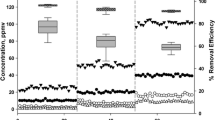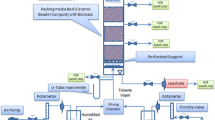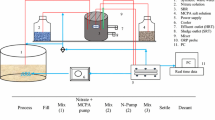Abstract
A two-stage reactor system was developed for the continuous degradation of gas-phase trichloroethylene (TCE). Methylosinus trichosporium OB3b was immobilized on activated carbon in a TCE degradation reactor, trickling biofilter (TBF). The TBF was coupled with a continuous stirred tank reactor (CSTR) to allow recirculation of microbial cells from/to the TBF for the reactivation of inactivated cells during TCE degradation. The mass transfer aspect of the TBF was analyzed, and mass transfer coefficient of 3.9 h−1 was estimated. The loss of soluble methane monooxygenase (sMMO) activity was modeled based on a material balance on the CSTR and TBF, and transformation capacity (T c) was determined to be 20.2 \(\mu\)mol mg−1. Maximum TCE degradation rate of 525 mg 1−1 d−1 was obtained and reactor has been stably operated for more than 270 days.
Similar content being viewed by others
Abbreviations
- a :
-
activity of sMMO (TCE per cell and time, nmol mg−1 min−1)
- A :
-
cross-sectional area of TBF (cm2)
- a max :
-
maximum activity of sMMO (nmol min−1 mg−1)
- B :
-
bleed rate (ml min−1)
- C g :
-
outlet TCE concentration in gas phase of TBF (mol l−1)
- C g0 :
-
inlet TCE concentration in gas phase of TBF (mol l−1)
- C l :
-
TCE concentration in liquid phase of TBF (mol l−1)
- C*l :
-
TCE concentration in interface of liquid phase of TBF (mol l−1)
- C s :
-
TCE concentration in activated carbon support of TBF (mol l−1)
- C b :
-
TCE concentration in biofilm of TBF (mol l−1)
- C x :
-
TCE concentration in liquid phase of TBF (mol l−1)
- ΔC g :
-
C g0 − C g (mol l−1)
- F g :
-
gas flow rate of TBF (ml min−1)
- F l :
-
liquid flow rate to TBF (ml min−1)
- F′l :
-
F l − B (ml min−1)
- h :
-
height of TBF (cm)
- H :
-
Henry’s constant (atm l mg−1)
- k l a :
-
gas/liquid mass-transfer coefficient (h−1)
- R :
-
ideal gas constant (atm l mol−1 K−1)
- P g :
-
partial pressure of gas (atm)
- r :
-
rate of TCE degradation (mg l−1 d−1)
- S :
-
growth substrate concentration in CSTR (mol l−1)
- S 0 :
-
growth substrate concentration of inflow to CSTR (mol l−1)
- S′:
-
growth substrate concentration of outflow from TBF (mol l−1)
- ΔS :
-
S 0 − S (mol l−1)
- t :
-
time (h)
- T :
-
kelvin temperature (K)
- T c :
-
transformation capacity ( \(\mu\)mol mg−1)
- V 1 :
-
CSTR working volume (l)
- X d :
-
dead cell concentration in CSTR (mg ml−1)
- X′d :
-
dead cell concentration of outflow from TBF (mg ml−1)
- X max :
-
maximum cell concentration (mg ml−1)
- X v :
-
viable cell concentration in CSTR (mg ml−1)
- X′v :
-
viable cell concentration of outflow from TBF (mg ml−1)
- X t :
-
total cell concentration (mg ml−1)
- Y :
-
yield coefficient (cell per substrate, mg mg−1)
- Greek symbols::
-
- α1 :
-
F′l/F l (dimensionless)
- α2 :
-
B/F l (dimensionless)
- α3 :
-
V 1/F l (min)
- α4 :
-
F g/F l (dimensionless)
- ɛb :
-
fraction of biofilm (dimensionless)
- ɛg :
-
fraction of gas phase (dimensionless)
- ɛs :
-
fraction of activated carbon support (dimensionless)
- ɛx :
-
fraction of liquid phase (dimensionless)
- μ:
-
specific grow rate in CSTR (h−1)
- μmax :
-
maximum specific grow rate in CSTR (h−1)
- φ:
-
viable cell fraction in CSTR (dimensionless)
References
Alvarez-Cohen L, McCarty PL (1991) Two-stage disperse growth treatment of halogenated aliphatic compounds by cometabolism. Environ. Sci. Technol. 25: 1387–1393
Chang HL, Alvarez-Cohen L (1995) Transformation capacities of chlorinated organics by mixed cultures enriched on methane, propane, toluene, or phenol, Biotechnol. Bioeng. 45: 440–449
Chang HL, Alvarez-Cohen L (1997) Two-stage methanotrophic bioreactor for the treatment of chlorinated organic wastewater. Wat. Res. 31: 2026–2036
Ensley BD (1991) Biochemical diversity of trichloroethylene metabolism. Annu. Rev. Microbiol. 45: 283–299
Fennel DE, Nelson YM, Underhill SE, White TE, Jewell WJ (1993) TCE degradation in a methanotrophic attached-film bioreactor. Biotechnol. Bioeng. 42: 859–872
Fitch MW, Weissman D, Phelps P, Georgiou G, Speitel G (1996) Trichloroethylene degradation by Methylosinus trichosporium OB3b mutants in a sequencing biofilm reactor. Wat. Res. 30: 2655–2664
Kang JM, Lee EY, Park S (2001) Cometabolic biodegradation of trichloroethylene by Methylosinus trichosporium is stimulated by low concentrations of methane or methanol. Biotechnol. Lett. 23: 1877–1882
Lee EY (2001) Bioreactor systems for the cometabolic biodegradation of trichloroethylene. Kor. J. Biotechnol. Bioeng. 16: 527–532
Lee EY (2003) Continuous treatment of gas-phase trichloroethylene by Burkholderia cepacia G4 in a two-stage continuous stirred tank reactor/trickling biofilter system. J. Biosci. Bioeng. 96: 572–574
Lee EY, Kang JM, Park S (2003) Evaluation of Transformation Capacity for Degradation of Ethylene Chlorides by Methylosinus trichosporium OB3b. Biotechnol. Biopro. Eng. 8: 309–312
Lee EY, Ye BD, Park S (2003) Development and operation of a trickling biofilter system for continuous treatment of gas-phase trichloroethylene. Biotechnol. Lett. 25: 1757–1761
Livingston AG (1991) Biodegradation of 3,4-dichloroaniline in a fluidized bed bioreactor and a steady-state biofilm kinetic model. Biotechnol. Bioeng. 38: 260–272
Love Jr. OT, Eilers RG (1982) Treatment of drinking water containing trichloroethylene and related industrial solvents. J. Am. Water Works Assoc. 74: 413–425
Oldenhuis R, Oedzes JY, van der Waarde JJ, Janssen DB (1991) Kinetics of chlorinated hydrocarbon degradation by Methylosinus trichlorosporium OB3b and toxicity of trichloroethylene. Appl. Environ. Microbiol. 57: 7–14
Shah NN, Park S, Taylor RT, Droege MW (1992) Cultivation of Methylosinus trichosporium OB3b: III. Production of particulate methane monooxygenase in continuous culture. Biotechnol. Bioeng. 40: 705–712
Sipkema EM, de Koning W, van Hylckama Vlieg JE, Ganzeveld KJ, Janssen DB, Beenackers AA (1999) Trichloroethylene degradation in a two-step system by Methylosinus trichosporium OB3b. Optimization of system performance: use of formate and methane. Biotechnol. Bioeng. 63: 56–68
Strandberg GW, Donaldson TL, Farr LL (1989) Degradation of trichloroethylene and trans-1,2 dichloroethylene by a methanotrophic consortium in a fixed-film packed-bed bioreactor. Environ. Sci. Technol. 23: 1422–1425
Sun AK, Wood TK (1997) Trichloroethylene mineralization in a fixed film bioreactor using a pure culture expressing constitutively toluene ortho-monooxygenase. Biotechnol. Bioeng. 55: 674–685
Taylor RT & Hanna ML (1995) Laboratory treatability studies for resting-cell in situ microbial filter bioremediation. In: Bioaugmentation for site remediation. Battelle press, pp. 15
Tschantz MF, Bowman JP, Donaldson TL, Strong-Gunderson JM, Palumbo AV, Herbes SE, Sayler GS (1995) Methanotrophic TCE biodegradation in a multi-stage bioreactor. Environ. Sci. Technol. 29: 2073–2082
Tsien HC, Brusseau GA, Hanson RS, Wackett LP (1989) Biodegradation of trichloroethylene by Methylosinus trichosporium OB3b. Appl. Environ. Microbiol. 55: 3155–3161
van Hylckama Vlieg JET, de Koning W, Janssen DB (1997) Effect of chlorinated ethene conversion on viability and activity of Methylosinus trichosporium OB3b. Appl. Environ. Microbiol. 63: 4961–4964
Westrick JJ, Mello JW, Thomas RF (1984) The groundwater supply survey. J. Am. Water Works Assoc. 5: 52–59
Author information
Authors and Affiliations
Corresponding author
Rights and permissions
About this article
Cite this article
Hwang, J.W., Choi, Y.B., Park, S. et al. Development and mathematical modeling of a two-stage reactor system for trichloroethylene degradation using Methylosinus trichosporium OB3b. Biodegradation 18, 91–101 (2007). https://doi.org/10.1007/s10532-006-9040-3
Received:
Accepted:
Published:
Issue Date:
DOI: https://doi.org/10.1007/s10532-006-9040-3




